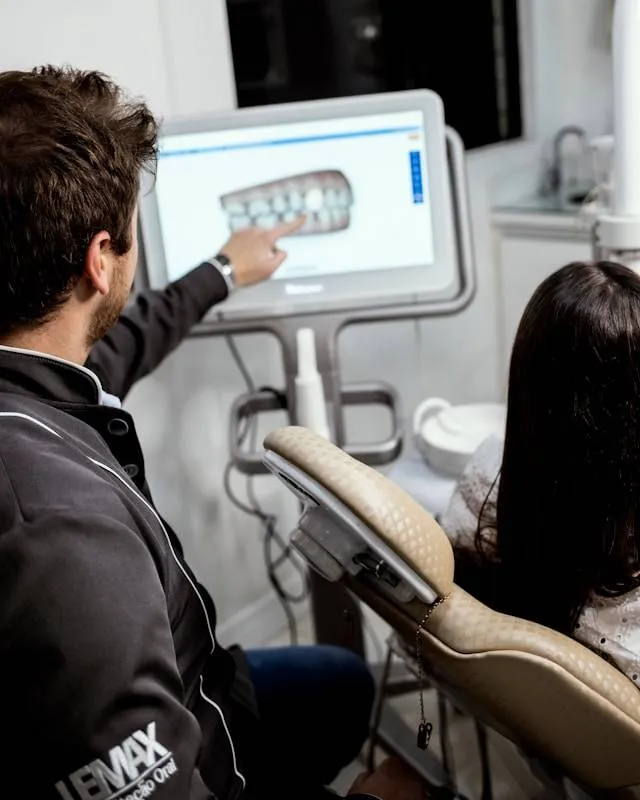Metal braces are a popular and effective orthodontic method, using metal brackets that are fixed to the surface of the teeth. These brackets are connected to each other by a metal wire, creating force to move the teeth to the desired position.
This method has been used and refined for decades, and it remains a popular choice for many people who want straight, beautiful teeth. Metal braces can effectively treat a variety of dental problems, from crooked teeth to bite problems.
Metal braces include the following main components:
1. Brackets: Are small metal parts that are fixed to the tooth surface.
2. Archwire: A thin metal wire that is threaded through the brackets, creating force to move the teeth.
3. Elastics: Used to secure the archwire to the bracket and provide additional traction when needed.
4. Bands: Used for molars to enhance adhesion.
Working principle:
- The archwire creates force on the teeth through the brackets.
- This force stimulates the regeneration of alveolar bone, allowing teeth to move.
- The doctor will adjust the curvature and change the archwire during treatment to achieve the desired results.
Metal braces are suitable for many subjects, including:
1. People with crooked and crowded teeth.
2. People with incorrect bite (such as open bite, deep bite, cross bite).
3. People with gaps between their teeth.
4. People with buck teeth or underbite.
5. Children and adolescents are in the stage of jaw bone development.
6. Adults who want to improve their teeth but have a limited budget.
Metal braces are especially effective for complex cases that require a lot of tooth movement.
Advantage:
1. High efficiency: Can treat most teeth and bite problems.
2. Reasonable cost: Usually the most economical choice among orthodontic methods.
3. High durability: Less likely to break during use.
4. Does not require high patient cooperation: Because it is fixed on the teeth.
5. Suitable for all ages.
Disadvantages:
1. Aesthetics: Easily visible when smiling or talking.
2. Can cause discomfort: Braces can rub against lips and cheeks.
3. Oral hygiene is more difficult: Careful attention must be paid to hygiene to avoid tooth decay.
4. Limit eating certain foods: Avoid hard, sticky foods to avoid damaging the braces.
The metal braces procedure usually includes the following steps:
1. Examination and consultation:
- The doctor will check your oral health.
- Take X-rays and dental impressions to plan treatment.
2. Prepare teeth:
- Clean teeth thoroughly.
- Dry the tooth surface.
3. Attaching braces:
- Use special dental glue to attach braces to each tooth.
- Shine a light on the glue to harden it.
4. Install the bowstring:
- Thread the archwire through the brackets.
- Fix the bowstring with elastic bands or metal pins.
5. Care instructions:
- The doctor will instruct you on oral hygiene and braces care.
6. Re-examination and adjustment:
- Usually every 4-6 weeks.
- The doctor will change the bow wire or adjust the traction.
6. Treatment time and stages
Treatment time with metal braces usually lasts from 18 to 36 months, depending on the complexity of each case. The treatment process can be divided into main stages:
1. Alignment phase (6-8 months):
- Teeth begin to move to the correct position on the jaw.
- Use a thin, soft bowstring to apply gentle force.
2. Teeth straightening phase (6-8 months):
- Teeth continue to move and rotate to the correct position.
- Use a stiffer bowstring to create more force.
3. Bite adjustment phase (6-12 months):
- Focus on correcting the bite.
- Elastic bands can be used to create traction between the upper and lower jaws.
4. Completion stage (3-6 months):
- Adjust small details to achieve optimal results.
5. Maintenance phase:
- After your braces are removed, you will need to wear a retainer to keep your teeth in their new position.
Proper oral care when wearing metal braces is important to ensure good treatment results and prevent problems such as tooth decay and gingivitis. Here are some tips:
1. Oral hygiene:
- Brush your teeth after every meal, at least twice a day.
- Use a toothbrush specifically for people with braces.
- Use dental floss or an interdental brush to clean between teeth and around braces.
2. Use mouthwash:
- Rinse your mouth with salt water or a fluoride mouthwash to prevent tooth decay.
3. Diet:
- Avoid hard, chewy foods that can damage braces.
- Limit sweets and carbonated drinks.
- Cut food into small pieces before eating.
4. Use dental wax:
- Use dental wax to protect the oral mucosa from rubbing against the braces.
5. Avoid bad habits:
- Do not chew hard objects such as ice or hard candy.
- Do not use your teeth to open the bottle cap.
- Don't bite your nails.
6. Re-examination on time:
- Go for follow-up visits as scheduled by your doctor to have your braces checked and adjusted promptly.
The cost of metal braces is usually lower than other orthodontic methods. However, the cost can vary depending on the dentist and the complexity of the treatment. Here are some factors that affect the cost:
1. Complexity of the treatment
2. Treatment time
3. Doctor's experience and reputation
4. Dental location
In Vietnam, the cost of metal braces usually ranges from 25 million to 45 million VND. Many dental clinics offer installment payment packages to help patients pay easily.
Compare metal braces with some other orthodontic methods:
1. Ceramic braces:
More aesthetic than metal braces.
Higher cost.
Equally effective to metal braces.
2. Clear braces (Invisalign):
The ultimate aesthetic, almost invisible.
The cost is significantly higher.
Suitable for mild to moderate cases.
Requires high patient compliance (wearing braces at least 20-22 hours/day).
3. Self-ligating braces (Damon):
Reduce friction, can shorten treatment time.
Less need for follow-up visits.
Costs more than conventional metal braces.
4. Incognito/Lingual braces:
Absolutely no visible brackets.
Highest cost.
Difficult to clean, can cause tongue discomfort.
Requires highly experienced doctors.
Quick comparison table:
| Features | Metal braces | Ceramic braces | Invisalign | Self-ligating braces | Lingual braces |
| Effective | Very good | Very good | Good | Very good | Very good |
| Aesthetics | Least | Rather | Very good | Rather | Great |
| Expense | Short | Medium | High | Medium-High | Very high |
| Treatment time | Medium | Medium | Medium | Shorter | Longer |
| Comfort level | Short | Medium | High | Medium | Short |
10. Common problems and solutions
During the process of wearing metal braces, you may encounter the following problems:
1. Toothache:
Cause: Due to the force of the bowstring.
Solution: Take over-the-counter pain relievers (paracetamol, ibuprofen). Apply ice to your cheek. Eat soft foods.
2. Mouth ulcers:
Cause: Due to braces rubbing against the oral mucosa.
Solution: Use dental wax to cover the sharp edges of the braces. Rinse your mouth with warm salt water. Use a topical medication for mouth ulcers.
3. The bracket is loose:
Cause: Eating hard, chewy food. Strong impact.
Solution: Contact your orthodontist immediately to have your braces reattached.
4. Bowstring poked in cheek:
Cause: The archwire is lengthened due to tooth movement.
Solution: Use dental wax to cover the end of the wire. Contact your orthodontist to have the wire shortened.
5. Tooth decay, gingivitis:
Cause: Poor oral hygiene.
Solution: Brush your teeth thoroughly after every meal. Use dental floss and interdental brushes. Rinse with an antibacterial mouthwash.
Important: Contact your orthodontist if you experience any problems during your braces treatment. Self-treatment may affect the treatment results.
Choosing a reputable dental clinic and an experienced orthodontist is key to ensuring the metal braces process is successful and safe. Here are some criteria for your reference:
Operating license: The dental clinic has a full operating license issued by the Department of Health.
Team of doctors: Doctors have professional degrees in orthodontics, experience and reputation in the industry.
Facilities: Modern equipment, ensuring sterility.
Service: Enthusiastic and thoughtful consultation, with clear warranty policy.
Cost: Reasonable and transparent prices.
Reviews: Refer to patient reviews on social networking sites and forums.
Questions to ask your orthodontist:
Does the doctor have experience treating cases similar to mine?
What type of metal braces does the doctor use? How is the quality?
What is the specific treatment process?
What does the treatment cost include? Are there any additional costs?
What is the warranty policy?
Here are some frequently asked questions about metal braces:
During the braces process, you may feel some discomfort for the first few days after the wires are attached or changed. This feeling is usually short-lived and can be controlled with pain medication.
Treatment time is usually 18-36 months, depending on the complexity of each case.
Costs range from 25 million to 45 million VND, depending on the dentist and the complexity of the treatment.
In some cases, teeth need to be extracted to create space for teeth to move. Your doctor will evaluate and advise you specifically.
Brush your teeth thoroughly after every meal, floss, and see your doctor regularly.
In the beginning, you should eat soft, easy-to-chew foods. Avoid hard, tough, sticky foods.
Metal braces are an effective, economical and suitable orthodontic method for many people. Although there are some disadvantages in terms of aesthetics and comfort, the advantages in terms of effectiveness and cost still make this method a popular choice. If you are looking for a reliable orthodontic solution, consider metal braces and consult your orthodontist for specific advice.
Tip: Don't hesitate to invest in your smile! A beautiful set of teeth not only makes you more confident, but also improves your oral health and quality of life.
Contact Sakura Dental, Sakura doctors will advise you! 🚀





